#Prisoners of War
Explore tagged Tumblr posts
Text

Three German prisoners, one wounded, captured in the attack on Vampire Farm near Potijze, during the Battle of the Menin Road, Sept 1917
#ww1#wwi#the great war#german army#photography#first world war#war history#world war 1#world war one#world war i#circa 1917#1917#germany#great war#germen#soldiers#western front#tumbler#photo#wwi era#1910s#ww1 history#wwi history#prisoners of war#history
57 notes
·
View notes
Text
Yesterday, after two years in russian captivity, my sister-in-law's friend returned home.
His relatives didn't recognize him. Shaved head, morbidly thin, quiet, and with an empty stare - he looked nothing like himself. His mother, though, who kept fighting for her son and for his brothers-in-arms, who organized rallies to remind everyone about the prisoners of war and conditions in the russian prisons - she recognized him. I saw the video of their first meeting, how she hugged him and told him everything would be fine now.
The worst part? He didn't recognize her.
#some days i think i can't hate russians more#and then this happens#personal#prisoners of war#russian war crimes#russian war in ukraine#russia is a terrorist state#russia must burn
62 notes
·
View notes
Note
I have been reading your posts about Republicans. Honestly, the only good Republican in modern times I can name is the late John McCain. Agree with him or not, he was a good man at least. The face of Mitch McConnell when McCain refused to repeal Obamacare was priceless. He refused to repeal it because he knew that just repealing it would leave a ton of Americans without healthcare while waiting for a replacement, which could take years considering how slow politics often is (assuming they even had a plan to begin with).
I find it very difficult to believe Mitch McConnell wasn't aware of the fact it would take a long time to replace Obamacare with something that may or may not be better and that in the meantime numerous Americans would be without healthcare.
It's honestly sickening to think about.
I agree!
It's also worth noting this moment from John McCain's run for President:
youtube
Something I want to focus on here though is that it shows pretty well how even as John McCain was running a respectable campaign, the Republican PEOPLE were already becoming Trump's electorate.
There's this myth that I sometimes see that presents Trump as being a corrupting figure that somehow turned Republicans bad. And the Republican voters just are swept up in it.
So I think it's worth looking back at the time the Republican frontrunner tried countering the racist fearmongering about Obama, and HIS crowed booed him for it.
It's no surprise that this crowd would later support Trump as he mocked McCain for being a prisoner of war.
"He's not a war hero. He's a war hero because he was captured. I like people that weren't captured,”
As far as I'm concerned, most Republicans have been this for a while. Trump just gave them permission to embrace their hate more publicly.
#republicans#gop#maga#john mccain#donald trump#trump#politics#veterans#us military#pow#prisoner of war#prisoners of war#war hero#war heroes#military#army#us politics#political#politicians#conservatives
28 notes
·
View notes
Text
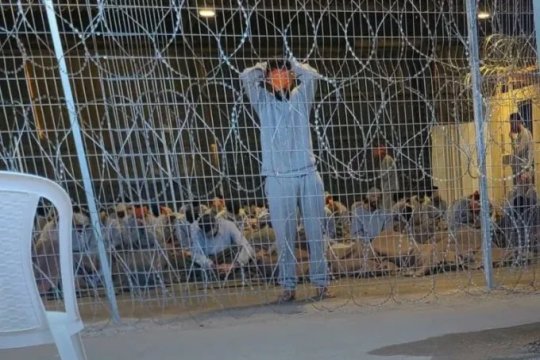
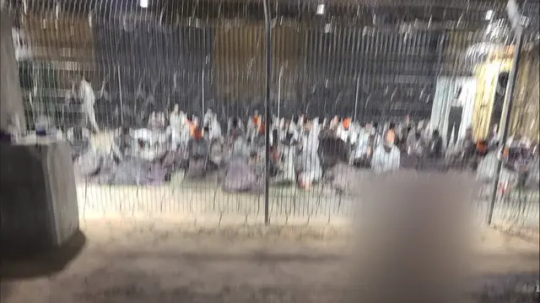
Strapped down, blindfolded, held in diapers: Israeli whistleblowers detail abuse of Palestinians in shadowy detention center..Finally, #CNN SPEAKS (May, 2024)
Sde Teiman: Israeli whistleblowers detail abuse of Palestinians in shadowy detention center | CNN
| تحقيق لسي إن إن: - انتهاكات وتعذيب لمعتقلين فلسطينيين على يد جنود إسرائيليين في مركز اعتقال سري بالنقب. - شهادات مخبرين إسرائيليين كشفت أن المعتقلين الفلسطينيين يعيشون ظروفا قاسية للغاية.
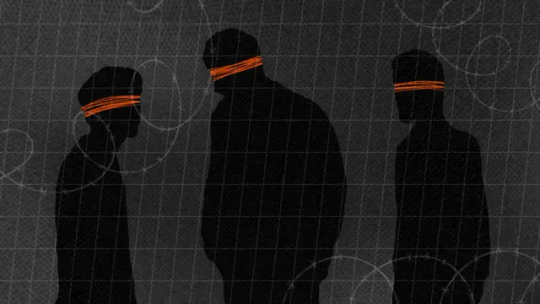
Update from #Khan Yunis (May, 2024) :
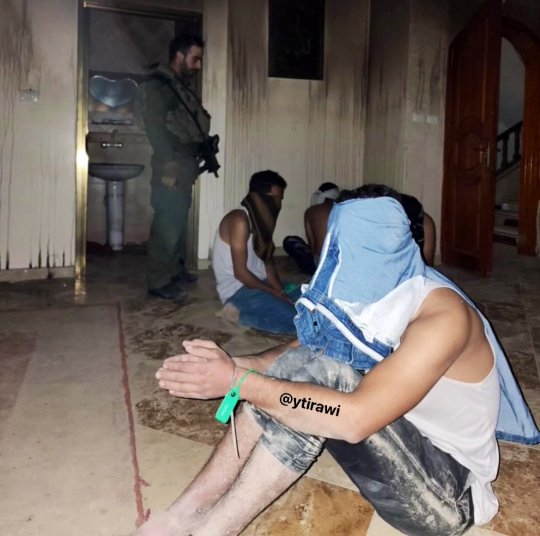
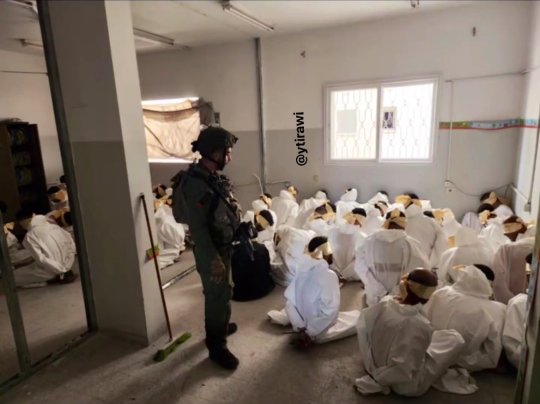
Palestinian citizens, who have been kidnapped by Israel's military from Khan Yunis | (Jan., 2024)
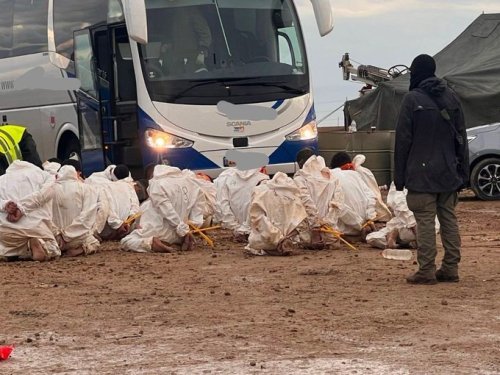
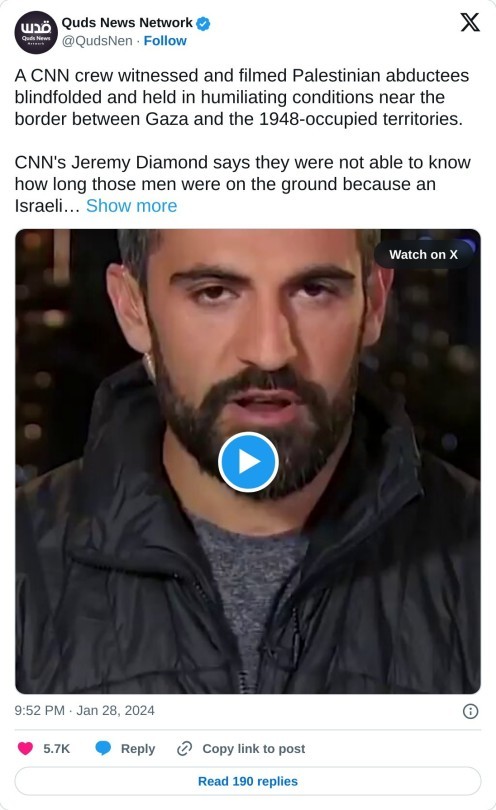
Palestinian men detained by Israeli forces since the start of the war in Gaza have told Middle East Eye how they were physically tortured with dogs and electricity, subjected to mock executions, and held in humiliating and degrading conditions. (March, 2024)
www.middleeasteye.net
long live the resistance : This is what Farouq looks like after severe... (tumblr.com) Dec, 2023
#ISRAEL#crimes against humanity#torture#amnesty international#genocide#gaza#palestine#journalism#free palestine#journal#investigative journalism#freedom#humanitarian#humanity#human rights#newspaper#world news#news on gaza#palestine news#wow#war crimes#guantanamo#abu ghraib#prisoners#prisoners of war#photographers on tumblr#rafah#CNN#breaking news#investigation
77 notes
·
View notes
Text
First Russian Military Operation Outside Its Territory. Ukrainian Armed Forces Combat Operations in Kursk Region.
You are watching the news from the weekly rally at the Russian Embassy in Lisbon. Today is August 10, 2:30 PM.
The five-day war in Georgia from August 8 to 12, 2008, was Russia's first "special operation" outside its territory. Journalist Georgy Kobaladze says that Georgian authorities commemorate the anniversary on August 7, marking the Ossetian army's attack on a Georgian village near Tskhinvali as the beginning. https://www.svoboda.org/a/kapkan-i-vtorzhenie-15-let-s-nachala-rossiysko-gruzinskoy-voyny/32538906.html
The Ossetians trace the origins of the war with Georgia back to 1989, when the USSR was collapsing. https://www.bbc.com/russian/features-45106205
After the Dagomys Agreement, Georgia maintained difficult but peaceful relations with the regions of Abkhazia and the Tskhinvali region (South Ossetia). In 2008, Georgia began to consider joining NATO. https://www.youtube.com/watch?v=mE7_p7WISo4
Matthew Bryza, who was involved in the US mediation plan for this war, told Dozhd in an interview how steps to contain Russia were removed during the process of working with the German Foreign Ministry. https://youtu.be/uK6pyU5DuQM?feature=shared&t=294
The human rights organization "Human Rights Watch" in its research discusses violations of humanitarian law on both sides, including systematic arson, robbery, and beatings of residents of Georgian villages by South Ossetian forces after the withdrawal of Georgian troops. https://www.hrw.org/reports/georgia0109ruweb.pdf
In 2021, the Strasbourg court found that Russia exercised control over Abkhazia and the Tskhinvali region and therefore bears responsibility for these violations. The Russian representative stated in court that the fragments of the Iskander missile used by Russia, presented by the Georgian side, were stolen, dismantled, and planted by the CIA. https://www.bbc.com/russian/features-55737376
Volunteer and activist David Katsarava said in an interview with Dozhd: "For us, the war against Ukraine is a continuation of ours." https://www.youtube.com/watch?v=uK6pyU5DuQM
Since August 6, the Armed Forces of Ukraine have been conducting an operation in the Kursk region. The combat zone has already reached 430 square kilometers. The YouTube channel "The Insider" reported briefly on the situation: people are evacuating on their own, Putin is distributing the usual 10 thousand rubles, and Russian generals ignored reports of Ukrainian forces concentrating on the border. https://www.youtube.com/watch?v=8vbljcaYy1k
On August 9, politician Yulia Navalnaya stated: "Putin's war has finally come to Russia." She addressed those aiding Putin's war efforts: "No one will forget what you did to our country. You are working for a killer, but it's never too late to stop." https://www.youtube.com/watch?v=8-HoR9OJ6mU
On August 7, Vladimir Osechkin held a stream on his YouTube channel in memory of Oleksandr Ishchenko, a member of the Azov regiment who was killed in Russian captivity, and called for information about this crime to be sent to him for investigation. https://www.youtube.com/watch?v=jBi3sO5Rq5M
Azov commander Svyatoslav Palamar published a forensic medical examination report on his Facebook page confirming the brutal murder and violation of the Geneva Convention relative to the Treatment of Prisoners of War. https://www.facebook.com/share/p/FWoEAf9XxGmrShd2/
On January 12 of this year, the Memorial Human Rights Center recognized prisoners of war from the Ukrainian Azov Regiment as political prisoners, as they consider the Supreme Court's decision to recognize the Azov Regiment as a terrorist organization to be unlawful. https://memopzk.org/news/my-schitaem-politzaklyuchyonnymi-voennoplennyh-iz-ukrainskogo-polka-azov/
Proofs and links in the description. Subscribe and help!
52 notes
·
View notes
Text
"Ukrainians who stayed on to work at the plant say they did so under duress. Employees report that Russian occupiers coerced them into adopting Russian citizenship and signing contracts with Rosatom. According to a recent IAEA report, the plant has announced that workers still officially employed by Energoatom, Ukraine’s state nuclear company, are barred from the site. The workforce “now consists of former Energoatom employees who have adopted Russian citizenship and signed employment contracts with the Russian operating entity, as well as staff who have been sent to the ZNPP from the Russian Federation.”
On top of that, current and former employees of the ZNPP, some of whom escaped past enemy lines, have said that Russia brutalized the plant’s dwindling workforce, resorting to torture to keep workers in line.They also report that Russia is violating international law by using the plant as a military staging ground, further increasing the risks to the facility. This claim has been supported by satellite evidence.
From the start of the war, Energoatom has objected to the occupation of the ZNPP, and raised alarms about the dangers the plant faces. Recently, the IAEA has also issued warnings about the degrading state of the ZNPP and the continued potential for a meltdown. In February, it issued a bulletin warning that the plant’s last backup external power line had been disrupted, creating a “precarious” situation. Today, the IAEA’s director general, Rafael Mariano Grossi, met with President Vladimir Putin and Alexei Likhachev, the head of Rosatom, in a closed-door session to discuss his concerns about the plant. But the agency has thus far been ineffectual in compelling Russia to cooperate, and its authority does not extend to claims of human-rights abuses away from the plant, even when they involve employees.
The result is a crisis unprecedented in the history of nuclear power. A disaster at the facility would be most immediately harmful to the people living near it. But the ZNPP is located in the watershed of the Dnipro River, which flows through southern Ukraine and into the Black Sea. If a meltdown occurs at the ZNPP and affects the waterways, experts indicate that all of southern Ukraine might be at risk for contamination.
...
In their stories of working at the ZNPP after the Russian occupation began, several sources describe incidents of detentions, interrogations, and torture. Kostiantyn Chebaievskyi worked at the ZNPP until August 2022, when he says he was arrested at the end of his shift and imprisoned by Russians. Chebaievskyi says that he was accused of communicating with Ukrainian authorities and that interrogators beat him and tried to force him to make a false confession. Other people employed at the ZNPP at the time say that cells intended to hold four to six people were used to detain up to 20 prisoners without any food, save what their relatives were able to bring on visits.
Chebaievskyi says that one form of torture involved what his captors called “a phone call to Lenin.” According to Chebaievskyi, the men would clip one cable to his earlobe and another to his finger, and then interrogate him while they turned the crank on a modified field telephone that would deliver a shock. “Everything goes dark,” he said. “All that you see is white lighting.” Chebaievskyi said that the interrogators repeated the procedure over and over, demanding to know his supposed contact in Ukraine. He also reported that some prisoners were forced to give interviews for Russian television crews, reciting prewritten scripts that were complimentary toward Russia. Chebaievskyi was released after 18 days, and then managed to escape from the city.
Other ZNPP employees corroborate allegations of abuse and torture. Volodymyr Zhaivoronok is a 50-year-old former equipment operator who says he was imprisoned for 53 days, many of them in the same cell where Chebaievskyi ended up. Zhaivoronok says Russian personnel beat the prisoners, targeting their backs, necks, and shoulders. “One is bringing you into the room, and another six people come there,” Zhaivoronok told me and my colleagues at the Reckoning Project. “They come in with batons, pistols.” He recalled that the torture room was covered in blood, and prisoners were forced to clean it. Zhaivoronok said that during one of the sessions, his torturers shot him in the side with a rubber bullet.
...
ZNPP employees claimed in 2022 that their plant also became a shield [like Chernobyl]. They reported that they heard what they believed to be Russian mortar shells launched from within or near ZNPP territory, and also saw Russian military equipment in crucial locations of the plant, including turbine halls near reactors. This equipment included armored personnel carriers and trucks, tanks, anti-aircraft systems, and rocket launchers. These sources also stated that Russian soldiers—possibly hundreds of them—have been deployed to the plant, and have complete access to spaces designated for evacuation and sheltering. These claims were supported in a September 2023 report, commissioned by Greenpeace, that used satellite imagery to identify signs of military activity in the vicinity of the plant. An accident involving military equipment and ordnance could damage the systems needed to cool the reactors, and could lead to a leak of radioactive material.
The operation of Zaporizhzhia, like that of all nuclear-power plants, is subject to international law, and to regular inspections by the IAEA, a treaty organization that reports to the United Nations. Since the beginning of the occupation, the IAEA and its director general, Grossi, have made several visits to Ukraine and to the ZNPP in particular, and have offered ongoing assistance to the plant’s administrators. In May, Grossi told the UN Security Council that the situation at the ZNPP “continues to be extremely fragile and dangerous,” and noted that the plant did not have enough staff to maintain safety measures, even with the reactors shut down. Grossi added that there had been seven occasions since the occupation began when the plant lost off-site power and had to rely on diesel generators, “the last line of defence against a nuclear accident.” (The plant has since suffered another external power loss.) In that address, Grossi asked that Russia abide by certain principles in its operation of the plant, including refraining from using it for military weapon storage."
- Nataliya Gumenyuk, "Looming Disaster at the Zaporizhzhia Nuclear Power Plant," The Atlantic. March 6, 2024.
#zaporizhzhia nuclear power plant#nuclear power plant#zaporizhzhia#international atomic energy agency#russia-ukraine war 2022#russian invasion of ukraine#prisoners of war#torture#military occupation#energoatom#rosatom
46 notes
·
View notes
Text

The international community is doing too little to ensure that Ukrainian prisoners of war are kept in proper conditions in accordance with the norms of the Geneva Convention on the Treatment of Prisoners of War! The Olenivka community once again calls on the ICRC and the UN to fulfill their mandates and monitor the conditions of detention of Ukrainian prisoners of war. We also appeal to the representatives of the state bodies of Ukraine to hand over these materials to international partners and international organizations in order to once again show everyone that Russia uses various tools to torture our soldiers, and to find mechanisms for their early return home.
https://t.me/olenivkafamilies/1481
37 notes
·
View notes
Text
When Santa’s Elves Were German

German POWs held at St Erth, Cornwall making toys
Between the years 1945 and 1948 400,000 Axis POW’s were imprisoned in UK Prisoner of War camps.
During these years thousands of Christmas toys were made by the former Wehrmacht soldiers and initially given to orphaned children and children of injured British soldiers however many other children can remember receiving the extremely well made toys which were made primarily from scrap materials.

A jewellery box made by the POWs at St Erth of which the recipient still lives in the village.

A musical box made by German POWs in the UK.
In my current village of St Erth, Cornwall many of the villagers can remember the POWs and a few continued to visit after the war and often their families get in touch on the village Facebook page.
The POWs were given a number of freedoms in the years after the war and many of them worked for the village farmers in their fields and lived in their homes alongside their families. Some of the prisoners were little older than boys and the villagers received letters from their parents thanking them for their kind treatment.
At least two of the POWs settled in the village after the war and a few returned for holidays and often a reunion was held at the village pub.
The POWs also built the first mechanical water pump for the village which still stands today.

The St Erth village water pump built by POWs in 1943.
12 notes
·
View notes
Text

Americans who spent time in Russian captivity (after came to Russia on own their will) vs. Ukrainians who spent time in Russian captivity (after they fought protecting own country), August 2024...

23 notes
·
View notes
Text

14 notes
·
View notes
Text

American soldiers captured by the Chinese People's Volunteer Army near the Chosin Reservoir. November 1950.
#korean war#cold war#war history#korea#prisoners of war#1950s#photography#korean#south korea#north korea#us troops#chinese army#asia#1950#us army#us marines#military history#tumbler#photo#history
86 notes
·
View notes
Text
On Palestinian Prisoner's Day, Israel continues to arrest 9,400 Palestinians, including 200 children and 71 female prisoners. 253 Palestinians were executed in the occupation prisons, including 17 since October 7.
#gaza#free gaza#free Palestine#Palestine#Israel#anti Zionist#torture#graphic content#prisoners of war#news
18 notes
·
View notes
Text

When workers are treated like prisoners
#workers of the world unite#workers rights#workers#political prisoners#prisoners of war#palestinian prisoners#prisoners#jail#prison#morale#wage slavery#slavery#chattel slavery#oppression#oppressor#free all oppressed peoples#pedagogy of the oppressed#oppressive#repression#ausgov#politas#auspol#tasgov#taspol#australia#fuck neoliberals#neoliberal capitalism#anthony albanese#albanese government#slavetothewage
25 notes
·
View notes
Text
I was reading an (open source) journal article last night about the medical treatment of American POWs in the War of 1812.
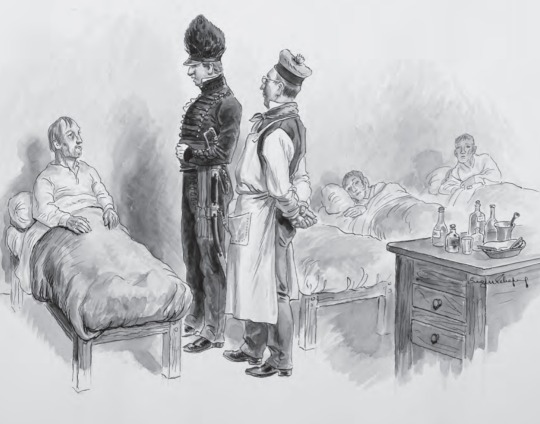
A British officer inspecting the sick in hospital, 1813.
The gist of the article is that American claims of mistreatment are overblown, and most prisoners received adequate medical care (under the circumstances) from their British captors. Relevant to my interests in both military history and the history of medicine, it gives an overview of the treatment of wounds and illness and the results. The author notes:
Few formal conventions dealt with the treatment of prisoners of war during the period. While it was common for combatant nations to agree upon temporary conventions once hostilities commenced, generally it was quasi-chivalric sentiments, notions of Christian conduct, and a sense of humanitarian obligation that moderated treatment of prisoners, allowing, for example, parole for officers and sometimes for enlisted personnel and care for sick and wounded soldiers.
It seems odd that military personnel could switch between trying to kill the enemy and trying to save his life with medical intervention, but it's well-known that soldiers actually don't like killing people (see Men Against Fire by S.L.A. Marshall and numerous other studies).
#war of 1812#military history#napoleonic#1810s#history of medicine#prisoners of war#war of 1812 soldiers seem so fragile to me#they constantly die from things like measles and tetanus#please let me give them chicken soup and antibiotics and vaccines
18 notes
·
View notes
Photo

Women’s Army Corps Cpl. Barbara Fenster (left) and Cpl. Genevieve E. Guethlein secure information from German prisoner of war Pvt. Frederick Bonk, captured in Tunisia. September 7, 1943, at Hampton Roads Port of Embarkation.
Record Group 336: Records of the Office of the Chief of Transportation
Series: Photographic Albums of Prints of Hampton Roads Port of Embarkation
Image description: Inside a tent, a young man in a German uniform with “AFRIKAKORPS” on his sleeve stands to the side of a desk. Seated at the desk are two women in Women’s Army Corps uniforms, who are writing. In the background are more desks and more German prisoners of war.
#archivesgov#September 7#1943#1940s#World War II#WWII#military#U.S. Army#Women's Army Corps#POW#prisoners of war#cw: nazis#cw: swastika#hopefully not actually visible at this resolution
49 notes
·
View notes
Text

Un MP américain fouille un officier SS – Bataille de Normandie – 1944
Photographe : Robert Capa
©Robert Capa International Center of Photography - Magnum Photos
#WWII#opération overlord#operation overlord#bataille de normandie#battle of normandy#prisonniers de guerre#prisoners of war#prisonniers allemand#german prisoners#police militaire#military police#MP#schutzstaffel#waffen-ss#officier SS#SS#robert capa#1944
59 notes
·
View notes